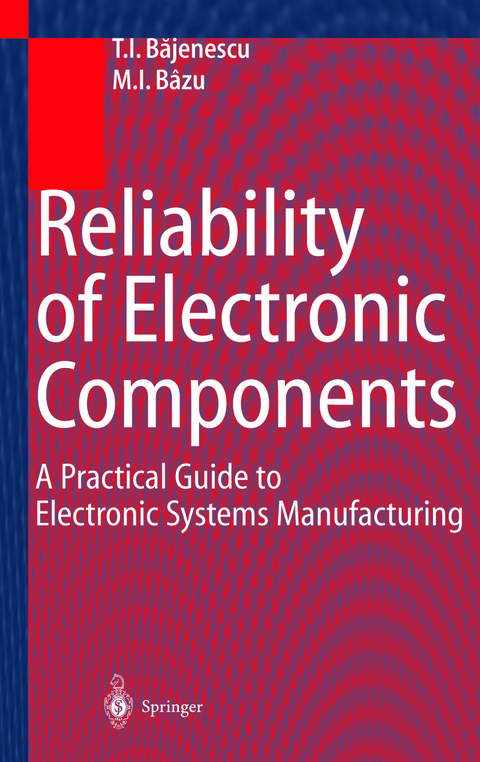
Reliability of Electronic Components
Springer Berlin (Verlag)
978-3-642-63625-7 (ISBN)
1 Introduction.- 1.1 Definition of reliability.- 1.2 Historical development perspective.- 1.3 Quality and reliability.- 1.4 Economics and optimisation.- 1.5 Probability; basic laws.- 1.6 Specific terms.- 1.7 Failures types.- 1.8 Reliability estimates.- 1.9 "Bath-tub" failure curve.- 1.10 Reliability of electronic systems.- 1.11 Some examples.- References.- 2 State of the Art in Reliability.- 2.1 Cultural features.- 2.2 Reliability building.- 2.3 Reliability evaluation.- 2.4 Standardisation.- References.- 3 Reliability of Passive Electronic Parts.- 3.1 How parts fail.- 3.2 Resistors.- 3.3 Reliability of capacitors.- 3.4 Zinc oxide (ZnO) varistors [3.39]...[3.45].- 3.5 Connectors.- References.- 4 Reliability of Diodes.- 4.1 Introduction.- 4.2 Semiconductor diodes.- 4.3 Z diodes.- 4.4 Trans-Zorb diodes.- 4.5 Impatt (IMPact Avalanche and Transit-Time) diodes.- References.- 5 Reliability of Silicon Transistors.- 5.1 Introduction.- 5.2 Technologies and power limitations.- 5.3 Electrical characteristics.- 5.4 Reliability characteristics.- 5.5 Thermal fatigue.- 5.6 Causes of failures.- 5.7 The package problem.- 5.8 Accelerated tests.- 5.9 How to improve the reliability.- 5.10 Some recommendations.- References.- 6 Reliability of Thyristors.- 6.1 Introduction.- 6.2 Design and reliability.- 6.3 Derating.- 6.4 Reliability screens by General Electric.- 6.5 New technology in preparation: SITH.- References.- 7 Reliability of Integrated Circuits.- 7.1 Introduction.- 7.2 Reliability evaluation.- 7.3 Failure analysis.- 7.4 Screening and burn-in.- 7.5 Comparison between the IC families TTL Standard and TTL-LS.- 7.6 Application Specific Integrated Circuits (ASIC).- References.- 8 Reliability of Hybrids.- 8.1 Introduction.- 8.2 Thin-film hybrid circuits.- 8.3 Thick-film hybrids.- 8.4Thick-film versus thin-film hybrids.- 8.5 Reliability of hybrid ICs.- 8.6 Causes of failures.- 8.7 Influence of radiation.- 8.8 Prospect outlook of the hybrid technology.- 8.9 Die attach and bonding techniques.- 8.10 Failure mechanisms.- References.- 9 Reliability of Memories.- 9.1 Introduction.- 9.2 Process-related reliability aspects.- 9.3 Possible memories classifications.- 9.4 Silicon On Insulator (SOI) technologies.- 9.5 Failure frequency of small geometry memories.- 9.6 Causes of hardware failures.- 9.7 Characterisation testing.- 9.8 Design trends in microprocessor domain.- 9.9 Failure mechanisms of microprocessors.- References.- 10 Reliability of Optoelectronics.- 10.1 Introduction.- 10.2 LED reliability.- 10.3 Optocouplers.- 10.4 Liquid crystal displays.- References.- 11 Noise and Reliability.- 11.2 Excess noise and reliability.- 11.3 Popcorn noise.- 11.4 Flicker noise.- 11.5 Noise figure.- 11.6 Improvements in signal quality of digital networks.- References.- 12 Plastic Package and Reliability.- 12.1 Historical development.- 12.2 Package problems.- 12.3 Some reliabilistic aspects of the plastic encapsulation.- 12.4 Reliability tests.- 12.5 Reliability predictions.- 12.6 Failure analysis.- 12.7 Technological improvements.- 12.8 Can we use plastic encapsulated microcircuits (PEM) in high reliability applications?.- References.- 13 Test and Testability of Logic Ics.- 13.1 Introduction.- 13.2 Test and test systems.- 13.3 Input control tests of electronic components.- 13.4 LIC selection and connected problems.- 13.5 Testability of LICs.- 13.6 On the testability of electronic and telecommunications systems.- References.- 14 Failure Analysis.- 14.1 Introduction [14.1]...[14.25].- 14.2 The purpose of failure analysis.- 14.3 Methods of analysis.- 14.4 Failure causes.-14.5 Some examples.- References.- 15 Appendix.- 15.1 Software-package RAMTOOL++ [15.1].- 15.2 Failure rates for components used in telecommunications.- 15.3 Failure types for electronic components [15.2].- 15.4 Detailed failure modes for some components.- 15.5 Storage reliability data [15.3].- 15.6 Failure criteria. Some examples.- 15.7 Typical costs for the screening of plastic encapsulated ICs.- 15.8 Results of 1000 h HTB life tests for CMOS microprocessors.- 15.9 Results of 1000 h HTB life tests for linear circuits.- 15.10 Average values of the failure rates for some IC families.- 15.11 Activation energy values for various technologies.- 15.12 Failures at burn-in.- References.- General Bibliography.- Reliability Glossary.- List of Abbreviations.- Polyglot Dictionary of Reliability Terms.
| Erscheint lt. Verlag | 16.10.2012 |
|---|---|
| Zusatzinfo | XLI, 509 p. |
| Verlagsort | Berlin |
| Sprache | englisch |
| Maße | 155 x 235 mm |
| Gewicht | 831 g |
| Themenwelt | Technik ► Bauwesen |
| Technik ► Elektrotechnik / Energietechnik | |
| Technik ► Maschinenbau | |
| Schlagworte | CMOS • Communication • Development • Integrated circuit • LED • Logic • optoelectronics • quality • Quality Control, Reliability, Safety and Risk • Reliability • static-induction transistor • telecommunications • Testing • Thyristor • Transistor • Varistor |
| ISBN-10 | 3-642-63625-X / 364263625X |
| ISBN-13 | 978-3-642-63625-7 / 9783642636257 |
| Zustand | Neuware |
| Haben Sie eine Frage zum Produkt? |
aus dem Bereich


